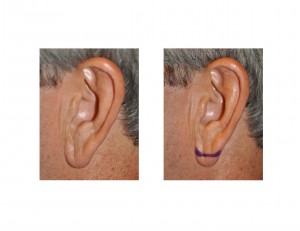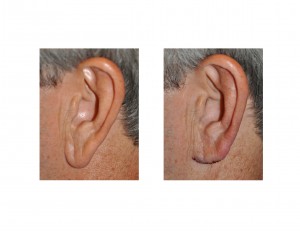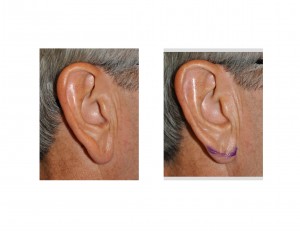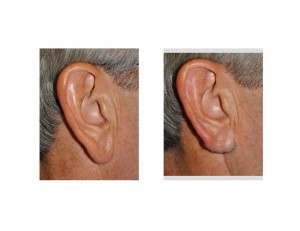Background: The earlobe is a part of the ear that is best known as a site of adornment by the placement of jewelry. It is rarely thought of as a body structure that ages or sags. But the earlobe is the only part of the ear that is not supported by cartilage, it is composed of only skin and fat. Thus it is prone to being stretched through long-term ear ring wear and gravity.
For many people the earlobe does get longer with age. This is most commonly referred to as ‘growing’ but it does not really grow anymore than someone who gets ‘long in the tooth’ has teeth that are growing. (this is gum recession which exposes more tooth length as it recedes) The earlobe gets longer because it stretches due to gravity and loss of skin elasticity. As it gets vertically longer it always gets a little thinner or less full in thickness.
A long earlobe can be an unaesthetic ear feature as it throws the ear shape out of balance. The typical vertical length of the entire ear is anywhere from 55mm to 60mm but a more proportionate measurement is that it should be as long as the nose. The lower end of the earlobe should generally not be below a horizontal line drawn from the nasal ala or greater than 20% of the total vertical ear length.
Case Study: This 58 year-old man wanted to reduce the size of his earlobes. While long earlobes were a family trait, they had gotten too long as he aged and he desired them to be shortened..but not by a lot. He did not want anyone to know that he had the procedure nor did he want any scars on the visible part of the earlobe.


The inferior rim resection technique is one earlobe reduction method that is the procedure of choice when the patient sees it as long but not excessively wide. For many men the lack of any visible scarring makes it appealing.
Case Highlights:
1) Elongation of the earlobe is a natural process due to gravity and/or ear ring wear. The earlobe does not grow but it does stretch.
2) One of the surgical techniques for earlobe reduction is rim shortening which places the scar in the most inconspicuous location.
3) All earlobe reduction procedures are done in the office setting under local anesthesia.
Dr. Barry Eppley
Indianapolis, Indiana




